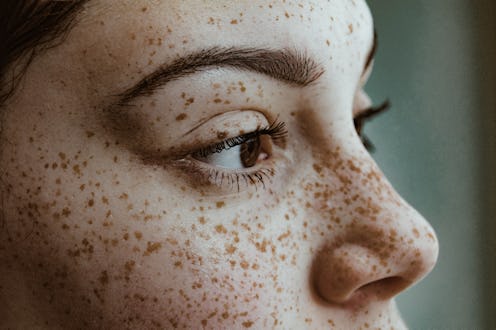(Hair)
Even Your Eyebrows Can Get Dandruff — Yes, Seriously
Expert tips on how to manage flaky brows.

Ever try filling in your brows only to have your seamless makeup thwarted by flaky skin? While you may think it’s just an innocent case of dryness, it could actually be dandruff. Yep, turns out the skin condition isn’t just reserved for your scalp. Even though the eyebrows are a lesser known area that can fall victim to it, eyebrow dandruff is still extremely common and affects millions of people, according to board-certified dermatologist and author Dr. Sandy Skotnicki.
Read more: 12 Products For Microbladed Brows That Keep Them Looking Natural
Dandruff on the eyebrows is classified similarly as dandruff on the scalp — seborrheic dermatitis — and it generally forms for the same reasons it can form on your head (more on that in a bit). Annoyances aside, eyebrow dandruff can create quite the beauty quandary considering the brows are such a prominent feature on the face, and 2021’s brow trends are all about a fluffy, bold brow. Not quite ready to let dandruff-laden brows get in the way of you nailing the bushy eyebrow look? Keep scrolling to learn how to manage it (and determine whether it’s what’s affecting your brows in the first place).
Eyebrow Dandruff: What It Looks Like
“Eyebrow dandruff basically looks like dry skin,” says Dr. Skotnicki. “It's typical for the area to be mildly red (though it may not have any redness at all) with soft tiny flakes of skin that can become loose when you scratch or rub the area.” The flakes can be white or yellow, but here’s the kicker: Though the condition itself is characterized by flakes, you may notice that your eyebrow area actually feels greasy. Take a good look at your brows the next time you’re ready to wash your face at the end of the day — are they oilier than usual? Is there any trace of dry, dead skin cells? If you’re unsure, it’s always best to consult a dermatologist before embarking on any new skin care regimen.
Eyebrow Dandruff: Why It Forms
In general, dandruff is more likely to form on areas that have a greater concentration of oil glands (that’s the face and, inevitably, eyebrows). Oil glands produce sebum, and sebum plays a role in dandruff, but Dr. Skotnicki says it’s not exactly clear how the two are intertwined. “Malassezia, a normally occurring organism on the skin, present mainly in hairy areas, plays a role in dandruff whereby there’s an interplay between the organism and sebum,” she notes. Why it is more active in some individuals and leads to seborrheic dermatitis is not well understood, but it’s said that this yeast feeds off of sebum and therefor thrives in oily areas.
Still, experts are able to pinpoint certain moments when dandruff can make an appearance — puberty being one of them. “It’s typical for dandruff to occur during puberty when sebum production increases,” says Dr. Skotnicki. Seasonal changes can be another culprit, according to NYC-based board-certified dermatologist Dr. Hadley King. “Season change can be a trigger that contributes to flares of seborrheic dermatitis,” she says. “While some people experience flares during fall and spring, other people experience flares during the winter when the skin tends to be drier.”
Finally, because dandruff is technically a mild skin inflammation, anything that can worsen it (think: harsh facial cleansers, overly fragrant face products, or irritating makeup products) may worsen it. So when in doubt — or to prevent a recurring flare — stick with gentle skin care products and fragrance-free formulas for both makeup and skin care.
Eyebrow Dandruff: How To Treat It
Though Dr. King says there’s no cure for dandruff, it is manageable. Over-the-counter shampoo ingredients — such as selenium sulfide, which has anti-fungal properties and can decrease Malassezia, irritation, and itching — can be helpful. Salicylic acid may also be useful, as it’ll help reduce scaling on the scalp. Finally, both Dr. Skotnicki and Dr. King recommend looking for ketoconazole as an ingredient in your shampoo — it inhibits fungus growth and also has mild anti-inflammatory properties.
Wondering how to apply an anti-dandruff shampoo to your brows? Dr. King recommends using these shampoos for your hair and simply letting the lather run down over the eyebrow area. “This ensures that the shampoo will be diluted and therefore less likely to cause skin irritation,” she says. “Alternatively, a small amount of the shampoo can be diluted with water and used to wash the eyebrow area.” Obviously, take care to keep your eyes shut during this process and rinse thoroughly to prevent irritation.
Another fix for brow dandruff is likely already sitting in your pantry: apple cider vinegar. It has antibacterial and anti-fungal properties, and Dr. Skotnicki says it lowers the skin’s pH, which can decrease the activity of the fungal organism that contributes to dandruff. And, if you’re really struggling, topical corticosteroids can also be helpful to decrease the inflammatory component in seborrheic dermatitis. Visit your primary care doctor or dermatologist for help identifying what prescription and over-the-counter treatments are best for your skin, and remember — dandruff, no matter where it is on your body, doesn’t have to feel unmanageable.